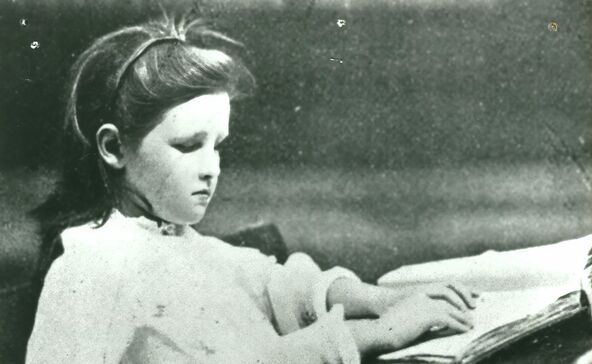- Vision
- Hearing
Never doubt what you can do in life—and do everything to the best of your ability. That’s the message Alice Betteridge, advocate and pioneer for the Australian deafblind community, shared with her large extended family. And it’s a message they’re still inspired by decades after her death in 1966.
Alice, who was born in 1901, was the first deafblind person to be formally educated in Australia. And, like her famous US peer Helen Keller, left her own remarkable legacy.
Her niece Sharon Betteridge remembers her Aunty Lal’s fierce determination, her ’cheeky’ outlook on life, her gift for teaching others, and her giving nature.
— Sharon Betteridge‘She’d say, “I can do that, try and stop me”. She was always combatting the discrimination of her disability. She broke new ground for people who are deafblind.
‘She was very giving and liked to pass on knowledge. And she was a character. You knew where you stood with her, and she was very good at everything she did.’
In search of an education
Young Alice, from the NSW Hunter Valley town of Maitland, was just two when she lost both her hearing and vision after contracting meningitis. Her family, clearly seeing her intelligence and wishing her to get an education, travelled to Sydney to what was then known as the NSW Institution for the Deaf and Dumb and the Blind – and now known as NextSense.
‘Granny Bet (Alice’s mum) heard there was a school at Darlinghurst Sydney that was starting up and she had heard of Helen Keller,’ Sharon says.
‘So, she contacted the school and took auntie from their home in the Hunter Valley to Darlinghurst.
‘But she was too young for school, so my grandparents did the best they could home back at their farm, until she was old enough for school.’
At age seven, Alice became our first student who was deafblind. Her teacher, Roberta Reid, taught her braille, and she became a fluent reader and writer. Reid also introduced young Alice to finger spelling, as was being used by Helen Keller in America. A whole new world began to open up.
A new world of communication
‘Starting school was tough in the beginning,’ Sharon says.
‘They started off with simple things, she was putting her shoe on one day, and Roberta did the sign for shoe on her hand. Alice would take her hand away, but Roberta was persistent, and kept putting her shoe in her hand, signing the word, and vice versa.’
It was a lightbulb moment and Alice was soon giving her whole family a crash course in hand signing.
‘Auntie Alice felt the school was her lifesaver, where she gained her independence. Without it, she’d be stuck in a house in Maitland, looked after by relatives, without the opportunities she’s had.’
As her confidence and her ability to communicate grew, Alice became something of a social butterfly, always up for a chat.
‘One of the kitchen workers at the Darlinghurst school could hand sign, so Alice would go and check what was on the menu, and make sure they put salt in the potatoes.’
‘She was prolific with deafblind signing; she was like a little typewriter and people would say “slow down”. It was a bit of a situation.
— Sharon Betteridge‘She liked to feel the music, and would put her hands on a piano, rock to the music, feel the vibrations, and do a jig behind the piano.
‘Sometimes when someone was singing, she’d put her hands on their voicebox to feel the vibrations.’
She was also a prize winning and perfectionist knitter, taking out several prizes at the Royal Easter Show. Using her well-honed adaptive skills, Alice developed her own knitting technique—she put notches on her wooden knitting needles to keep track of the stitches and had a system for checking she had enough stitches and no imperfections.
Meeting Helen Keller: the importance of deafblind advocacy
In 1948 Alice was finally able to meet Helen Keller – who visited Australia as part of a post-war international tour. Keller’s story was the very first book Alice read in braille.
The two women spent time together and Roberta Reid, who retained a strong connection with Alice, was able to connect with Helen Keller’s companion Polly Thompson.
Sharon says the Betteridge family all feel a strong connection to Alice one way or another.
And she believes her Auntie Lal would have been proud to know that events such as this week’s DeafBlind Awareness Week are now held to raise awareness and celebrate ability.
‘There needs to be more awareness of deafblindness, A lot of mainstream people don’t know how much it affects you to be deafblind, how much work goes into every day. I wish deafblind people weren’t so overlooked.’
Many children and families benefitted from the ability to communicate with each other via sign language and/or braille. That’s why Alice’s legacy – and that of her incredible teacher Roberta Reid – is so far reaching and foundational for the teachers and professionals who work with people who are deafblind today.
